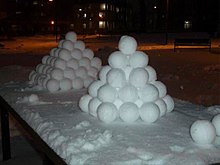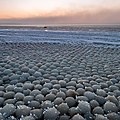
A snowball is a spherical object made from snow, usually created by scooping snow with the hands and pressing the snow together to compact it into a ball. [1] Snowballs are often used in games such as snowball fights.
A snowball may also be a large ball of snow formed by rolling a smaller snowball on a snow-covered surface. The smaller snowball grows by picking up additional snow as it rolls. The terms " snowball effect" and "snowballing" are derived from this process. The Welsh dance " Y Gasseg Eira" also takes its name from an analogy with rolling a large snowball. [2] This method of forming a large snowball is often used to create the components needed to build a snowman.
The underlying physical process that makes snowballs possible is sintering, in which a solid mass is compacted while near the melting point. [3] Scientific theories about snowball formation began with a lecture by Michael Faraday in 1842, examining the attractive forces between ice particles. An influential early explanation by James Thomson invoked regelation, in which a solid is melted by pressure and then re-frozen. [4]
When and how
When forming a snowball by packing, the pressure exerted by the hands on the snow is a determinant for the final result. Reduced pressure leads to a light and soft snowball. Compacting humid or "packing" snow by applying a high pressure produces a harder snowball, sometimes called an ice ball, which can injure an opponent during a snowball fight.
Temperature is important for snowball formation. It is hard to make a good snowball if the snow is too cold. [1] In addition, snowballs are difficult to form with a dry powdery snow. In temperatures below 0 °C (32 °F), there is little free water in the snow, which leads to crumbly snowballs. At 0 °C (32 °F) or above, melted water in the snow results in a better cohesion. [5] Above a certain temperature, however, the snowball too easily becomes slush, which lacks mechanical strength and no longer sticks together. [6] This effect is used in the rule that, in skiing areas, there is a high risk of avalanche if it is possible to squeeze water out of a snowball. [7]
Natural snowballs
Under certain unusual circumstances, natural snowballs form as a result of wind, without human intervention. These circumstances are: [8]
- The ground must have a top layer of ice. This will prevent the snowball from sticking to the ground.
- That ice must have some wet and loose snow that is near its melting point.
- The wind must be strong enough to push the snowballs, but not too strong.
In Antarctica, small windblown frost balls form through a different process that relies on electrostatic attraction; [9] these wind-rolled frost balls are known as yukimarimo.
Under other rare circumstances, in coastal and river areas, wave action on ice and snow may create beach snowballs or ball ice. [10]
-
Ball ice
-
Yukimarimo
-
Wind-rolled snowball
-
Beach snowball showing signs of denivation
Literary allusion
A snowball that turns into a child is a protagonist in a 1969 children's fantasy novel, The Snowball, by Barbara Sleigh. [11]
Gallery
 |
 |
 |
References
- ^ a b Schmitz, Kenneth S (2016). Physical Chemistry: Concepts and Theory. Elsevier. p. 206. ISBN 9780128006009.
- ^ Windham. "Windham | Y Gaseg Eira". Windham | Y Gaseg Eira. Retrieved 2023-09-22.
- ^ Denny, Mark (2011). Gliding for Gold: The Physics of Winter Sports. JHU Press. ISBN 9781421402154.
- ^ Riley, Frank (1988-01-14). "A snowball's chance". New Scientist.[ permanent dead link]
- ^ Steinkogler, Walter; Gaume, Johan; Löwe, Henning; Sovilla, Betty; Lehning, Michael (2014). Granulation of Snow: Experiments and Discrete Element Modeling (PDF). International Snow Science Workshop. Baniff. pp. 733–737. Archived from the original (PDF) on 28 March 2020. Retrieved 28 March 2020.
- ^ Morag Challenor (2006). "No-Ball Snow". In New Scientist (ed.). Does Anything Eat Wasps?: And 101 Other Unsettling, Witty Answers to Questions You Never Thought You Wanted to Ask. Simon and Schuster. p. 157. ISBN 9780743299176.
- ^ Luo, Jian (2012-01-16). "Developing Interfacial Phase Diagrams for Applications in Activated Sintering and Beyond: Current Status and Future Directions". Journal of the American Ceramic Society. 95 (8): 2358–2371. doi: 10.1111/j.1551-2916.2011.05059.x.
- ^ Rare self-rolling giant snow balls found in UK Archived 2010-01-12 at the Wayback Machine, The Telegraph, January 8, 2010
- ^ J. Nelson & M. Baker (2003). "Charging of ice-vapor interfaces" (PDF). Atmospheric Chemistry and Physics Discussions. 3: 41–73.
- ^ Emerson, Sarah (8 November 2016). "Thousands of Snowballs on This Siberian Beach Are Straight From a Fairy Tale". Motherboard. Vice Media. Archived from the original on 9 November 2016. Retrieved 8 November 2016.
- ^ University of Oxford libraries Retrieved 14 September 2018. Archived 17 October 2020 at the Wayback Machine

A snowball is a spherical object made from snow, usually created by scooping snow with the hands and pressing the snow together to compact it into a ball. [1] Snowballs are often used in games such as snowball fights.
A snowball may also be a large ball of snow formed by rolling a smaller snowball on a snow-covered surface. The smaller snowball grows by picking up additional snow as it rolls. The terms " snowball effect" and "snowballing" are derived from this process. The Welsh dance " Y Gasseg Eira" also takes its name from an analogy with rolling a large snowball. [2] This method of forming a large snowball is often used to create the components needed to build a snowman.
The underlying physical process that makes snowballs possible is sintering, in which a solid mass is compacted while near the melting point. [3] Scientific theories about snowball formation began with a lecture by Michael Faraday in 1842, examining the attractive forces between ice particles. An influential early explanation by James Thomson invoked regelation, in which a solid is melted by pressure and then re-frozen. [4]
When and how
When forming a snowball by packing, the pressure exerted by the hands on the snow is a determinant for the final result. Reduced pressure leads to a light and soft snowball. Compacting humid or "packing" snow by applying a high pressure produces a harder snowball, sometimes called an ice ball, which can injure an opponent during a snowball fight.
Temperature is important for snowball formation. It is hard to make a good snowball if the snow is too cold. [1] In addition, snowballs are difficult to form with a dry powdery snow. In temperatures below 0 °C (32 °F), there is little free water in the snow, which leads to crumbly snowballs. At 0 °C (32 °F) or above, melted water in the snow results in a better cohesion. [5] Above a certain temperature, however, the snowball too easily becomes slush, which lacks mechanical strength and no longer sticks together. [6] This effect is used in the rule that, in skiing areas, there is a high risk of avalanche if it is possible to squeeze water out of a snowball. [7]
Natural snowballs
Under certain unusual circumstances, natural snowballs form as a result of wind, without human intervention. These circumstances are: [8]
- The ground must have a top layer of ice. This will prevent the snowball from sticking to the ground.
- That ice must have some wet and loose snow that is near its melting point.
- The wind must be strong enough to push the snowballs, but not too strong.
In Antarctica, small windblown frost balls form through a different process that relies on electrostatic attraction; [9] these wind-rolled frost balls are known as yukimarimo.
Under other rare circumstances, in coastal and river areas, wave action on ice and snow may create beach snowballs or ball ice. [10]
-
Ball ice
-
Yukimarimo
-
Wind-rolled snowball
-
Beach snowball showing signs of denivation
Literary allusion
A snowball that turns into a child is a protagonist in a 1969 children's fantasy novel, The Snowball, by Barbara Sleigh. [11]
Gallery
 |
 |
 |
References
- ^ a b Schmitz, Kenneth S (2016). Physical Chemistry: Concepts and Theory. Elsevier. p. 206. ISBN 9780128006009.
- ^ Windham. "Windham | Y Gaseg Eira". Windham | Y Gaseg Eira. Retrieved 2023-09-22.
- ^ Denny, Mark (2011). Gliding for Gold: The Physics of Winter Sports. JHU Press. ISBN 9781421402154.
- ^ Riley, Frank (1988-01-14). "A snowball's chance". New Scientist.[ permanent dead link]
- ^ Steinkogler, Walter; Gaume, Johan; Löwe, Henning; Sovilla, Betty; Lehning, Michael (2014). Granulation of Snow: Experiments and Discrete Element Modeling (PDF). International Snow Science Workshop. Baniff. pp. 733–737. Archived from the original (PDF) on 28 March 2020. Retrieved 28 March 2020.
- ^ Morag Challenor (2006). "No-Ball Snow". In New Scientist (ed.). Does Anything Eat Wasps?: And 101 Other Unsettling, Witty Answers to Questions You Never Thought You Wanted to Ask. Simon and Schuster. p. 157. ISBN 9780743299176.
- ^ Luo, Jian (2012-01-16). "Developing Interfacial Phase Diagrams for Applications in Activated Sintering and Beyond: Current Status and Future Directions". Journal of the American Ceramic Society. 95 (8): 2358–2371. doi: 10.1111/j.1551-2916.2011.05059.x.
- ^ Rare self-rolling giant snow balls found in UK Archived 2010-01-12 at the Wayback Machine, The Telegraph, January 8, 2010
- ^ J. Nelson & M. Baker (2003). "Charging of ice-vapor interfaces" (PDF). Atmospheric Chemistry and Physics Discussions. 3: 41–73.
- ^ Emerson, Sarah (8 November 2016). "Thousands of Snowballs on This Siberian Beach Are Straight From a Fairy Tale". Motherboard. Vice Media. Archived from the original on 9 November 2016. Retrieved 8 November 2016.
- ^ University of Oxford libraries Retrieved 14 September 2018. Archived 17 October 2020 at the Wayback Machine



